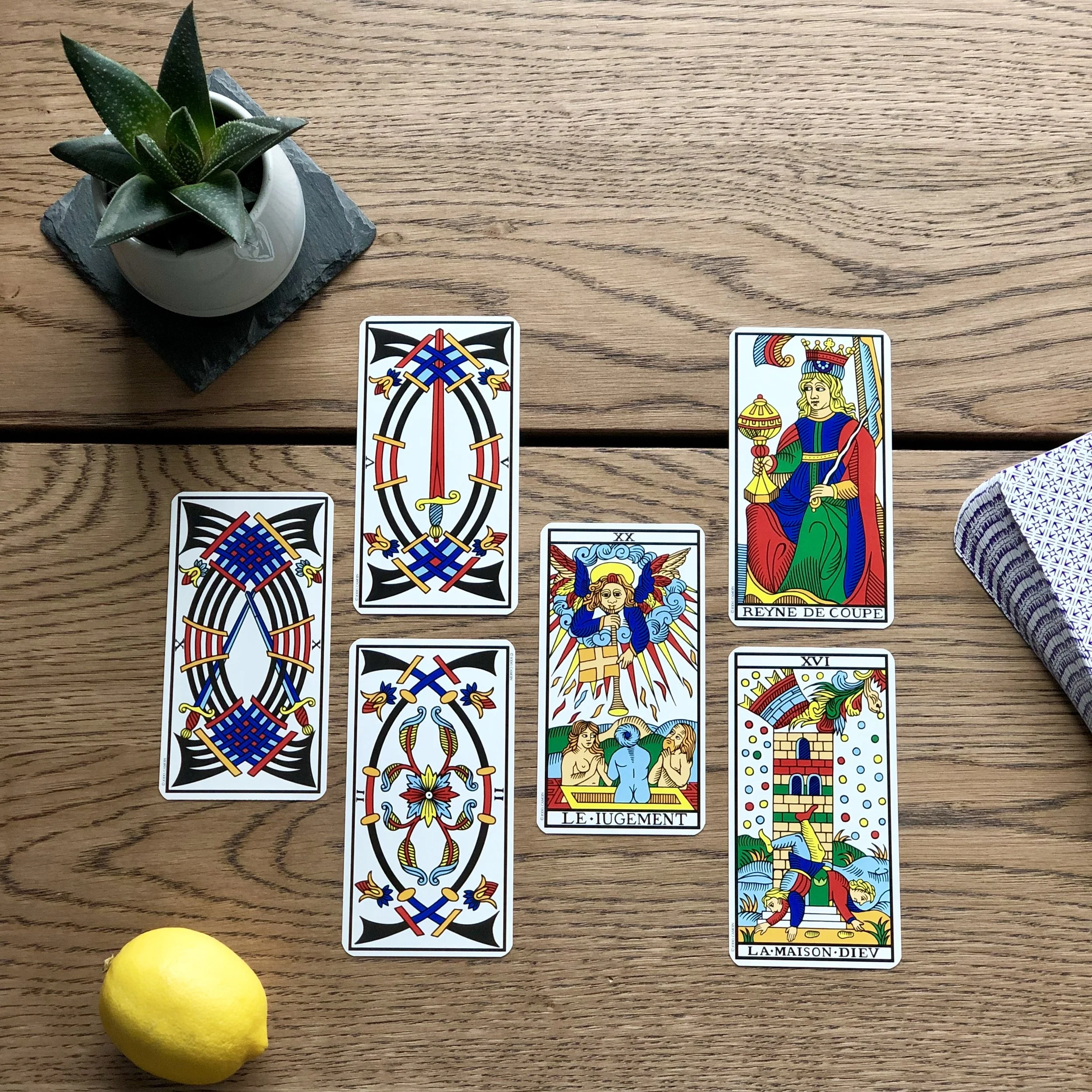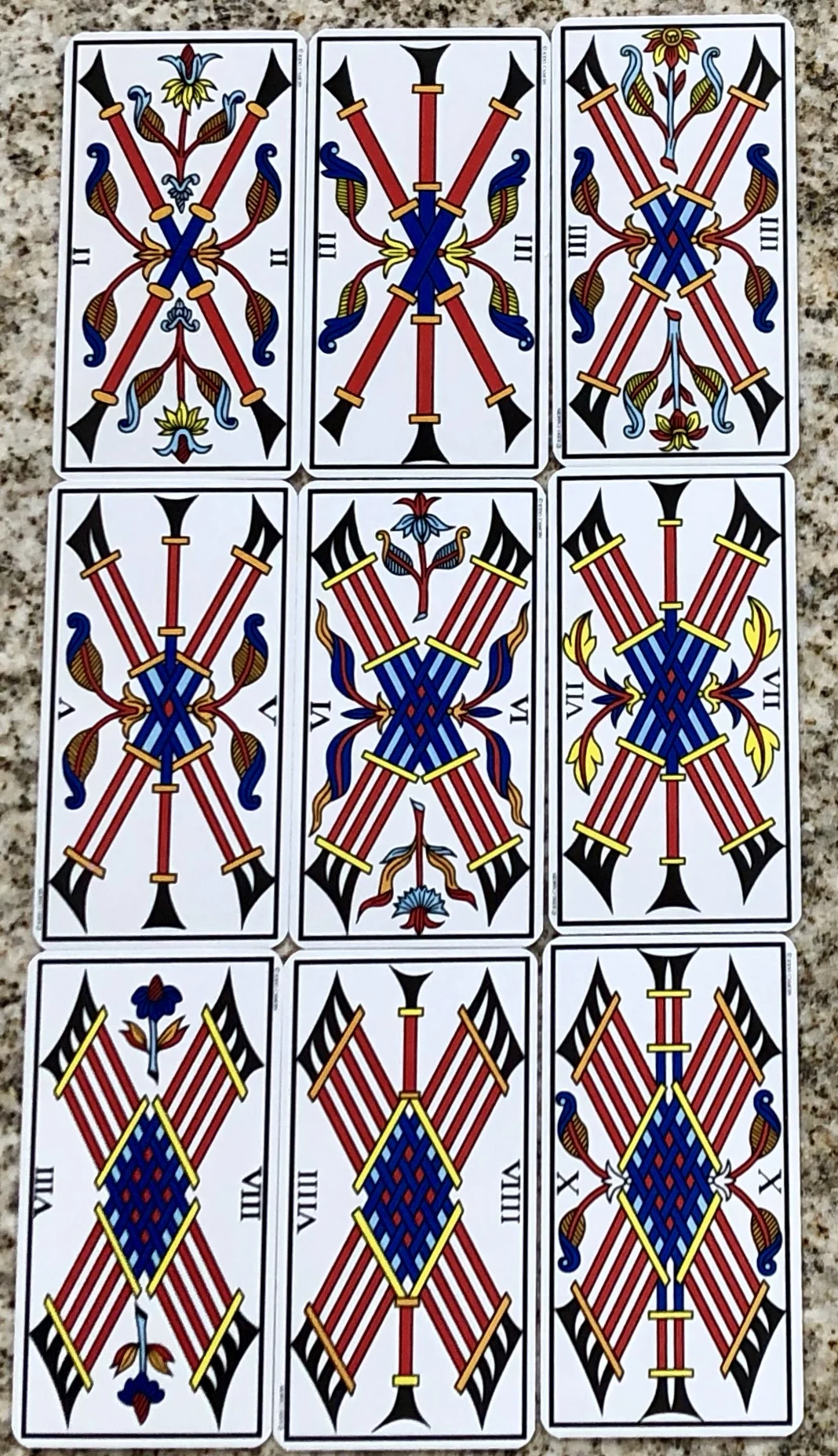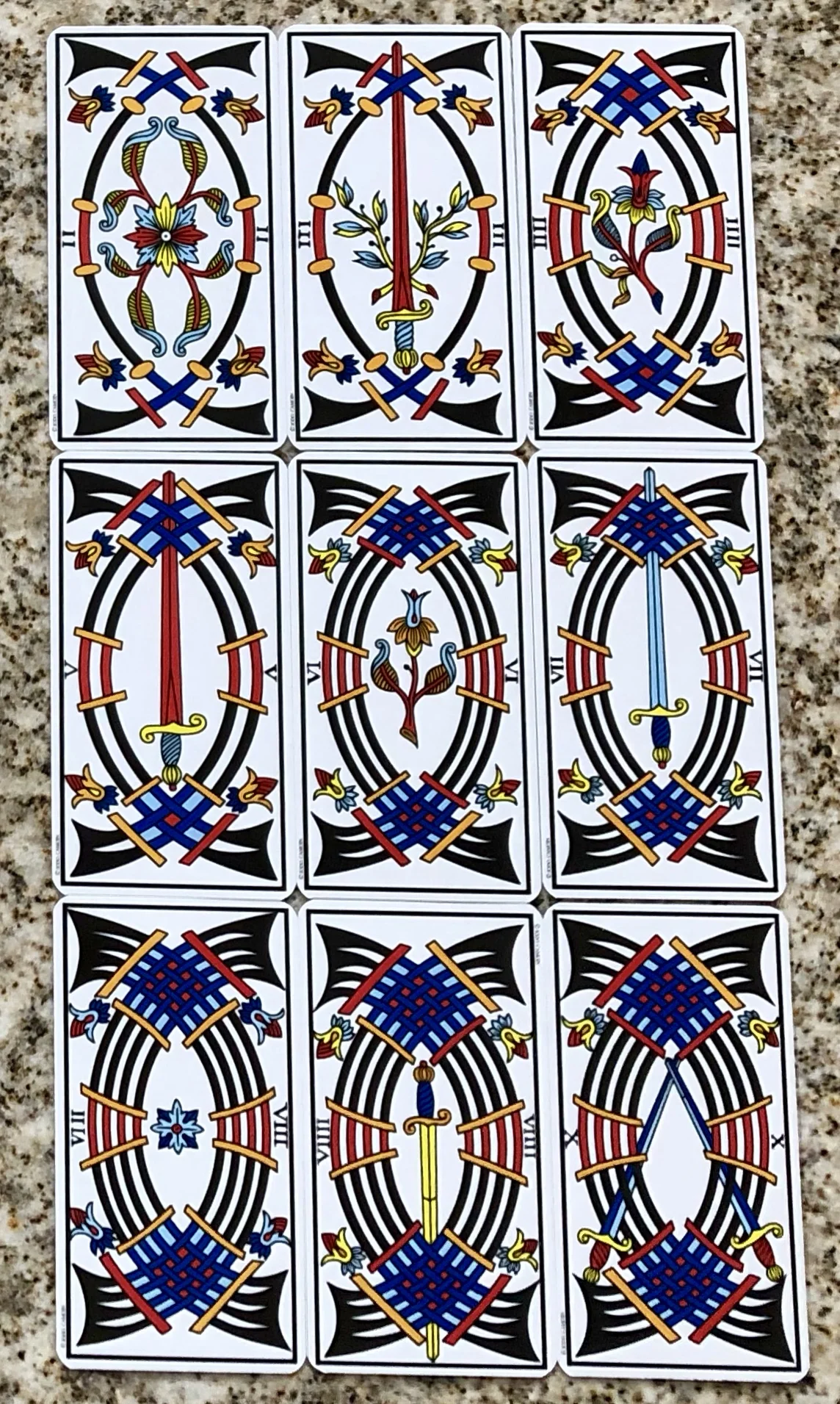Deck Interview: Tarot de Marseille (Jodorowsky)
The Tarot de Marseille is the “original” tarot deck on which other decks are based. The Smith-Waite / Rider-Waite / Rider deck is the one that most people know, but it’s from the early 20th century, whereas the Marseille is hundreds of years older (perhaps the 14th century), and the offshoots of the Marseille established the trumps and, eventually order, that became the major arcana we know today. The big difference between the Marseille and its most famous child (the Waite deck) is that the Marseille provides very little to go off of in terms of minor arcana imagery. Even the Tattoo Tarot, which is a Marseille-style deck has a lot of feeling compared to this deck.
More surprising still is that, at least in this version I bought by Alexandre Jodorowsky and published through Camoin, there are no minor or court arcana meanings, just color associations. The author of the little white book claims that this is the real tarot of Marseilles, based on interpreting various old decks for consistencies suggesting the original source on which they all drew. As a fully postmodern man, I find the idea of discovering the one true source of anything to be a fundamentally flawed and presumptuous quest. Finding the commonalities and discrepancies and creating something based on that? Awesome. Claiming to confidently know that it’s the one true version? Eye roll.
But there are some interesting concepts that create a new way of reading the minors beyond memorization of numerology.
For one thing, there’s the order of the suits: Batons/Sticks, Épées/Swords, Coupes/Cups, and, finally, Deniers/Coins. (A denier is a type of French coin, so Coins makes sense, and that translation fits the currency idea behind most of the non-English translations in the booklet—gold, coins, diamonds. But it’s worth noting that it's translated as Pentacles in English for some reason.) There’s no association between these suits and elements or even broad associations, though, and it’s just through later decks that this has more meaning. Still, the suits have symbolic associations one could use.
Also, there’s the “true” order of the courts: Page, Queen, King, and then Knight. The Thoth system uses Princess, Prince, Queen, and Knight, and the Waite system uses Page, Knight, Queen, and King. It doesn’t necessarily matter unless you’re using the order for some purpose, and even then, knowing what it means for your own practice is all that matters. But it’s worth noting that, at least in the book that came with my deck, it’s explained that way.
The big takeaway from the little white book and the minor arcana is the concept of coloring. Jodorowsky references white, black, red, and flesh as “neutral” colors because they’re the colors of alchemy (salt, mercury, and sulfur) and human flesh (a white person’s flesh color of course). Then there are six other cards that fall into light and dark: light/dark blue, light/dark yellow, and light/dark green.
As a side note, you’ll see that this deck has been garishly recolored, something that I avoided with my purchase of the Centennial edition for the Smith-Waite. What can I say? I haven’t been looking at this particular set of colors on cards for a decade or two, so they don’t bother me the same way. I’m sure they will in time. Also, the TdM cards have white backgrounds, so there’s a bit of a visual break.
What these colors mean is unclear, but I suppose one could determine that for him or herself. They do change over the course of the suit, so that might give interpretive clues. What’s also unclear is why the author thinks it’s weird that past tarot enthusiasts dove into alchemical symbols and Egyptian influences while he also references pentacles and alchemical coloring, But I digress, and this is already plenty long for an intro to an interview.
So let’s see what I have gotten to know about this deck before I start really using it in earnest. I’m using the same six-card interview spread that I always use. I should note that this deck is not generally meant to read with reversals, so I flipped any reversals right-side up.
INTERVIEWING THE TAROT DE MARSEILLE
Tell me about yourself. 10 Épées.
What are your strengths? 5 Épées.
And your limitations? 2 Épées.*
What are you here to help me learn? Le Jugement.
How can I work with you most effectively? Reyne de Coupe.
Where is our partnership headed? La Maison Dieu.
I included a lemon in my photo for the interview because I felt a bit sour about it on the surface, mostly because of the swords and la Maison Dieu at the end there. I really didn’t need to though. That I got three Épées for the first three cards is surprising because I made sure to a) shuffle and b) cut the deck for each card (they were apparently not as well shuffled as I thought the first time I did this reading, so I scrapped that), but also not surprising since this deck requires the application of a clear mind in a contorted way. Seeing my recent friend of the 5 was something of a comfort until I realized that this deck offers nothing in the way of pip meanings. Still, it’s a good excuse to force me to think about the card in some new way.
I get the impression from the first card that this deck and I could either work with each other or against each other since it’s the only Épées card with two swords depicted (as opposed to scabbards or whatever those bent things are supposed to be). Surrounding those two blades that could be working in tandem or clashing are the hemispheres of eight Épées that create a certain but dark mass of black and dark blue. There’s strength in that certainty and perhaps some aloofness. As I’ve implied above, I think the author thinks a bit highly of himself, so some of that might be coming through in this card of intelligence and fighting. The following two cards break down this idea (or divide it if you want to get literal): the 5 is a card of a fifth object intruding on the balance of the two intertwined pairs while the 2 is a card of balance and mutual pushing against each other, at least if we’re thinking in terms of fencing foils rather than scimitars. There’s something eye-like about the cards of this suit, especially the 2 since it has the central flower as the pupil/iris, as if they’re able to see things clearly, even if they’re bent for tactical strikes, unless the Batons pips (see below). But the contrast of the 5 and the 2 is enough to go off of here in seeing the deck’s strength as cutting through, straight to the point, while its weakness is in the ability to pause in balance and stop and smell the roses; there just isn’t that much to smell. The combination suggests that there are some clear meanings to get out of these cards, and there isn’t much point in trying to faff around getting to the heart of them.
The next three cards pack a bit more punch with a different color scheme and range of cards (trumps and a court rather than minors from just one suit). Seeing le Jugement as the card for what I’m to learn from this deck is surprising, but not a bad thing. I’d love to have that divine impression or revelation or strong reaction when using the deck. And seeing la Maison Dieu as the endpoint isn’t that bad. The card is extreme, but it could go in either direction. I can see it as being a disaster or, as per the little white book, a much more positive release of pent-up energy (i.e., “ejaculation” and “sexual release” are both possible meanings of the House of God). Anything is possible with a deck like this. I’m excited to use it for some old-school readings, like the ones included in the little white book and the one recently “toured” by Benebell Wen as a blast from the past: the “ancient reading” revived by MacGregor Mathers.
As for how I can work most effectively with this new deck, I see the Reyne de Coupe as being an importantly different card from the Queen of Cups. I see her in this reading as submitting and not fighting with the swords of the first card. If I want to learn from this deck, I have to submit to its rather alien differences in meaning. I can’t bring the old meanings from Smith-Waite along with me like I might for the Tattoo Tarot; they just aren’t supportable here. And if I give in to dealing with this deck on its own terms, I’ll know doubt learn things that I can bring back to the many “children” that have spun off of this old card game.
*Here are the Épées and Batons so you can see how similar they appear on the surface. Some Épées have blades on them (ignore the fact that one sword is pointed down; that was my mix-up; also, a bunch of batons are upside-down, but it’s less obvious), but otherwise they’re similar to the Batons but curved, which is the exact opposite of how I see Wands and Swords since I see Wands as forceful but an imprecise, spirally blasty sort of fire energy compared to the clear straight line of the thoughtful, airy Swords.
The cards pictured here are from the Tarot de Marseille by Alexandre Jodorowsky © 2016 Lo Scarabeo srl, via Cigna 110, 10155 Torino, Italy. All rights reserved, used by permission.



